|
Prince Charles explains 'pebble theatre'.
|
PEBBLE
|
|
Don Pierson [right] explains how a young Prince Charles made a request to join the Radio London fan club. |
|
|
Prince Charles explains 'pebble theatre'.
|
PEBBLE
|
|
Don Pierson [right] explains how a young Prince Charles made a request to join the Radio London fan club. |
|
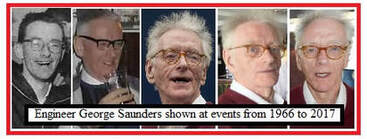 In yesterday's blog, we got to the point in George Saunders' storyline where he had just arrived at Greenore. He came in a car which John Gilman appears to have been driving, since George does not mention any additional occupant. "When we parked the car", said George, "I saw two ships, one looked like a ship and it was large." The larger vessel was the mv Caroline; ex-Iseult; ex-Fredericia. It had departed under tow from Rotterdam, Holland on February 13, 1964 and was then brought to a disused wharf at Greenore, Eire. As they walked past the ship, Gilman remarked "Oh that’s not ours” and then they arrived at a smaller ship that George thought looked like a coaster. This was the mv Mi Amigo; ex-Magda Maria; ex-Bon Jour which had arrived at Greenore under its own power on March 13, 1964. The ship remained at Greenore until April 17, 1964, for a total of 35 days. Therefore, even though George Saunders did not provide an exact date for his visit, we know that it was after Friday, March 13, since the ship was already there, and before Tuesday, March 23, 1964 when the mv Caroline departed from Greenore which provides a maximum window of 11 days. But since the mv Caroline was not getting ready to depart, it was during a much narrower window of time more akin to the week beginning on Sunday, March 15, 1964, and ending on Saturday, March 20, 1964. Therefore it is also possible that George Saunders had not as yet burned his bridge to Marconi, and that he undertook this visit on the weekend of Saturday-Sunday March 14-15, 1964. The reason for reaching that conclusion is because when Gilman and Saunders boarded the mv Mi Amigo and went below top deck, they met another man who caused George to react in obvious deference. This was all due to this man's immediate appearance. George figuratively bowed to the apparent superior authority of this man and then immediately began addressing him as "Sir". According to George, this man seemed to like George's manifestations of outward subservience, but then he began to grill George about his knowledge of broadcasting transmitters and radio engineering. George felt under pressure and that he was being given a verbal examination if he wanted the job. It was under this stress point that his interrogator suddenly turned to Gilman and said: "Right you'll do", meaning George Saunders, and not Gilman. If George had failed this test, which to this day he still rates as one of the more grueling impromptu technical examinations that he has ever had to take, then it is possible that he could have returned to his boring assignment at Marconi the following Monday to resume work on a marine radar handbook. In fact, this is the more likely scenario since George Saunders did not remain at Greenore to sail with the mv Mi Amigo when the ship departed on Friday, April 17, 1964. After George passed his aural examination and being told "Right you'll do", George later recounted: "So I said 'Okay', I was duly inducted." George then added: "A couple of days later, I was joined by another chap, the name fails me, I can see the face, gosh a chap called Grays no the name’s gone but he joined about two days after me and under John Gilman’s guidance, we did various things to getting it all set up." Whether George arrived on Friday March 13, 1964, or whether he stayed on for a few days longer on leave from Marconi, is not clear, but it is clear that he did not stay at Greenore and leave with the Mi Amigo. However, we also have another clue about the time frame as a result of George's additional comments during the same OEM interview about his time at Greenore when he was told: ".... we need quite a bit of work doing yet, it’s not ready to go. This ship has been on the air previously but the aerial has to be rigged." So clearly Harry Spencer who rigged the antenna had not as yet completed his work. While some may think that this concentration on the specificity of dates is tedious and totally unnecessary, the fact is that by skipping lightly over timelines, the vast majority of writers who have addressed the subject of offshore radio, have created fables out of thin air in order to connect dots that do not exist! But after passing his "aural exam", George was then invited to look around the Mi Amigo where everything below top deck was being lit by local power. They went down into the hold and looked at the two 10kW Continental Electronics transmitters, after which, they then moved on to inspect the studio and its gear. George Saunders continued: "Now we come back to the chap I mentioned earlier on, the chap who gave me the rigorous interview - now this chap was A. N. Thomas, and he had been chief engineer transmitters BBC, so that’s why I got such a heavy interview. And he had also been head of planning and insulation department as well." 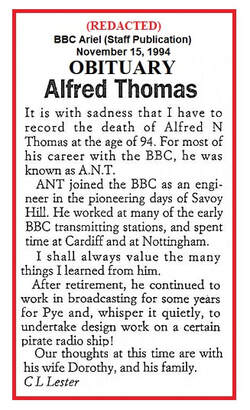 George Saunders sent us an obituary notice from the BBC staff magazine, and it seems that until it was pointed out to George Saunders, he was unaware that it was general knowledge that Alfred Nicholas Thomas had retired from the BBC and taken up employment with Charles Orr Stanley and his Pye Group of Companies. In some quarters, it was also common knowledge that Alfred Nicholas Thomas who was employed by the BBC at the time, not only knew of, but that he worked with Arthur Carrington of Marconi on a major project. But the dots connecting Thomas with Carrington, also connected both Thomas and Carrington with Pye, In addition to these connections, Thomas also became involved with fellow BBC retiree John Howard Gilman. Their connecting dots go from the BBC to Pye and a Pye assignment at Radio Veronica. Then their scene shifted to Swanson's GBOK alongside the Pye facility at Sheerness. Sensing the desperate mess that Allan James Crawford had repeatedly got himself into by trying to start an offshore radio station to promote his own music business, John Stanley, son of Charles Orr Stanley and head of the Pye Group of companies, then stepped in to take charge. This how and why Thomas and Gilman entered into the life of Allan James Crawford. However, what the average reader saw on their printed pages of the daily newspapers, was a collection of meaningless stories about Ronan O'Rahilly, and Crawford was under strict instructions to keep his mouth shut while two public relations firms got to work to spread misinformation. The real story behind this 'Electrical installation dispute' which unravels a lot of behind-the-scenes details that have been distorted or skipped-over by others, will be continued here in part 7, tomorrow. 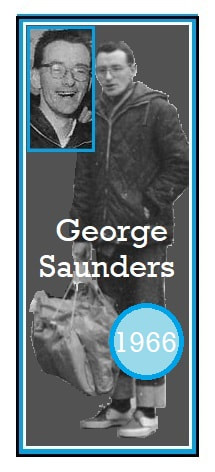 This is a composite picture of George Saunders created from two photographs. They were both taken in January 1966, which is approximately twenty-two months after George Saunders first met John Gilman in a pub at Chelmsford, Essex. To say that this is a strange tale is an understatement. To even suggest that it sounds unbelievable is not unreasonable, but in the absence of contradictory evidence, this is the tale that we are asked to believe, and subject to additional evidence to the contrary, we accept as being true. To recap, young George who is about twenty-two months younger than the picture you see to the left, has a job at Marconi where he has been employed for about four years. He has been assigned to write a handbook about marine radar, a subject that he finds boring and admits that he knows little about. But it is a steady job with a major British firm of international repute. One day in Chelmsford, Essex, after working on the marine radar handbook, bored George departed the factory gates of Marconi and went to his local pub to enjoy a pint, or something similar to wet his whistle. But as he raises his glass he also struck-up a conversation with another customer who was sitting at a nearby table. George did not know it at the time, but that fellow customer was not a local and neither did he work for Marconi. He was a man on a mission, which seems to have been meeting George Saunders. His name is John Howard Gilman and he was at the time, a retired BBC veteran technician, but on that particular day, it seems that he was there not by chance, but because he had been observing young George. Today, we might call it scouting for talent, or even stalking a victim, or in this instance a 'patsy'. Gilman was looking for a young and willing candidate whose credentials had previously been vetted and approved by Marconi who considered the mind of George Saunders to be worth the investment of training to become a part of their own technical team. So Gilman made Saunders an offer which apparently Saunders could not refuse, because a few days later, George Saunders called John Gilman to accept his offer. That offer required George Saunders to resign from his career at Marconi. We don't know the financial terms of Gilman's offer, but they must have been worthwhile for George Saunders to throw away a career and go to work for a company that he will later admit is couched in so much mystery, that he did not know who he was going to work for. He only learn later the strange mechanism by which he would be paid: His wages would flow from an arrangement with a Liechtenstein operation to a Swiss bank, and then they would become available to George via a London bank. George took the bait. He resigned from Marconi and then followed Gilman's instructions to the letter. He was to go from Chelmsford to Heathrow Airport where he would board a flight to Dublin in the Republic of Ireland. When he got off the plane he was to catch a train bound for Belfast, Northern Ireland, UK, but, he was to alight at Dundalk in the Republic of Ireland. Had George previously been told about the swirling mist of myths surrounding a young man named Ronan O'Rahilly when he alighted at the Dundalk, his mind might have jarred in recall years later with his own retelling of a momentary visit made by him in 1964 to its railway station. Two years after George's arrival at Dundalk station, and around the time that the pictures of him were taken that are shown at the top of this page; on Sunday, April 10, 1966, the railway station at Dundalk was renamed in honor of Tom Clarke. This man was one of the executed leaders of the 1916 Easter Rising against the British. Now at that time, the dusting-off of the fables relating to 'The O'Rahilly' were yet to follow. But in 1964, at this soon-to-be commemorated site of the Irish Republican rebellion against of British rule, George got off the train and there, as promised, was John Gilman waiting for him in a car. George has recited this story several times to different people, including a member of 'The Trio', and he has been asked what kind of job he thought that he was going to be embarking upon. George says that Gilman only told him that it concerned "engineering" and that it was of course related to Gilman's previous admission in the Chelmsford pub, that this "engineering" work concerned a project to put a commercial radio station on board a ship which would then drop its anchor off the coastline of England, and commence broadcasts to an audience in the British Isles. For the next part of the story young George might just as well have been telling the police what he knew about being kidnapped, except that he was not going anywhere against his will. He was willingly going off into a dark story by his own account, and it was to venture into an undertaking where he would work on something that he only had a vague idea about, and that he was doing this on behalf of a very mysterious operation that he knew almost nothing about. But, this is what George signed up to do after quitting his secure job with Marconi, which I suppose only raises the question of whether Marconi were as bored with George, as George seems to have been with the work Marconi assigned to him? Only George now knows the answer to that question. "I got off at Dundalk", says George, "and there sure enough was the chap I now know as John Gilman." That is what George said in an OEM interview. Does this mean that Gilman gave him a fake name when he met him in that Chelmsford pub? Who did George think that he was calling when he made his first telephone call to the man that "I now know as John Gilman"? Did he talk to Gilman on that phone call, or someone else, and who owned the telephone number that George called? We don't know because George did not tell us. George does say that the man he came to know as Gilman "took me in his car and he said 'the ship's actually at Greenore, which is some way away." George recalled that they traveled over "a narrow windy road" and he remembers passing a castle, but he could not at the time remember what its name was. So I turned to the Internet to see how many castles there are between Dundalk and Greenore in Eire. About 10 km or 7 miles northeast of Dundalk sits Castle Roche. It is perched on a rocky outcrop and it looks as if Gilman's car with George in it, would have driven along a winding road that passed beneath its sloping shadow. The castle dates back to 1236 when John de Verdun built its strong walls; deep moat and a secret passageway that led to the once fabled healing powers of waters sought by pilgrims drawn from St. Ronan's Well; which of course had nothing to do with the blarney that was liberally spashed around by that now departed eponymous member of the O'Rahilly family during his lifetime. George continues with his recital: ".... eventually we got to Greenore and it was quite surprising, it had been an old railway terminal and a very large hotel was there, I remember it was quite a big building, probably about three storeys high." Since this account by George Saunders has everything to do with events that led to the creation of Radio Caroline, we will continue our meticulous journey back in time with his account, tomorrow. 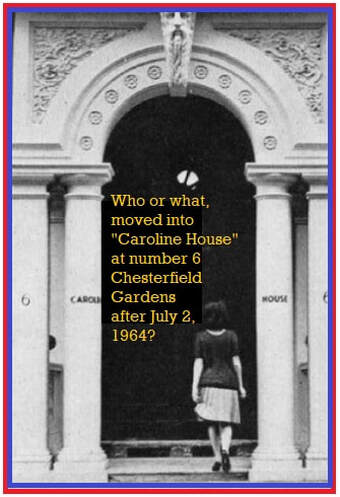 According to the joint press release issued by Eric White Associates and Leslie Perrin Associates on July 2, 1964, a "new operation" would be operating from 6 Chesterfield Gardens in London's Mayfair district. But neither White nor Perrin identified the name of the "new operation", although they did identify the names of both of the old operations, and their two managing directors. White and Perrin claimed that Allan Crawford and Ronan O'Rahilly had become "joint managing directors" of the "new operation". It seems that a lot of people were mystified as to what this "new operation" was, because according to the July 2, 1964 joint press release, two sales agencies, one in the UK and one in the Republic of Ireland had decided to form a joint enterprise. It also appears from the joint press release, that the "new operation" was going to be based in the UK because it had a London address at 6 Chesterfield Gardens, which neither of the previous entities had ever used. Those premises were tagged as "Caroline House", and according to the joint press release, both the broadcasts from the new Radio Caroline, which was the old Radio Atlanta, and the original Radio Caroline that had been moved to a position off the Isle of Man, were to be managed from this new address. There was no mention in the joint press release about ownership of either the ships, or the radio transmission equipment; nor details concerning employers of the announcers or the technical staff, or for that matter, the crew maintaining the ships. In fact, the joint press release created more mystery than anything else, and it led to a lot of people jumping to a lot of (false) conclusions, and they rushed ahead with a stream of misleading articles, broadcasts and books about Radio Caroline; what it was, and who had created it, or why it was created. Now a story did begin to bubble to the surface about Ronan O'Rahilly, but that was to disguise the true story. But almost everything written and said about this man was false. This propaganda was intended to deceive and to stop people from asking about the name of the "new operation". But true to the word of the joint press release, "departments" did begin to flood the premises of 6 Chesterfield Gardens. On the ground floor ("first floor" to people in the USA), was a combined sales department with no legal name of its own. This would later become a legal cause for concern after the Board of Trade began to investigate the "new operation" at 6 Chesterfield Gardens. However, there was also a technical and engineering department with its own departmental head named John Howard Gilman and his secretary Dorothy 'Kitty' Black. They were located at 'Caroline House on its first floor ("second floor" in the USA), they oversaw the work of the radio engineers on board both of the radio ships. One of the radio engineers hired by John Gilman and approved by his consulting overseer named Alfred Nicholas Thomas, was George Saunders. We can't say that Saunders worked for Radio Caroline, because that is not who he worked for, and there was no company named Radio Caroline that could have employed him. In 1960, George left school and went to work for Marconi as a junior engineer. It was his first job. He was more or less an apprentice moving around the firm and learning their procedures. His last job before being hired by Gilman in early 1964, was to write a Marconi marine radar handbook. This project did not appeal to him because, he admitted in an OEM interview during 2014, he didn't know much about radar frequencies, and consequently he had to rely upon other people for information. This resulted in George becoming disenchanted with his job at Marconi. For a long time after Gilman hired him, George puzzled about the way in which he was paid, but later still, after leaving behind anything to do with Radio Caroline, he asked for a letter of reference to give to his new employer. This letter puzzled George even more, because it merely confirmed that he had no idea about who he had been working for, and so it prompted him to recall the cloak and dagger way in which Gilman had hired him. George has fondly recited the same story to several people, and so we have reasonable confidence in what we think we know, is close enough to what actually happened. He says that one day after leaving work at Marconi in Chelmsford, he went to a local pub that Marconi employees tended to favor. He got his drink and looked around and saw a well dressed man in a suit who was sitting by himself at a table. George took his drink, walked over, sat down at the same table and began a conversation. They began talking about broadcasting transmitters and the stranger asked him what he was working on. George told him about the marine radio book project, and this led to a drift in topics towards ships in which George admitted that he had some knowledge of seasickness. John Howard Gilman introduced himself and told George that George was the sort of person he was looking for to assist with a new project: Gilman wanted to broadcast commercial radio programs to the UK, from a ship anchored in the North Sea.
George admitted later that he thought this 'chance' meeting was more than coincidence, and he leaned with suspicion towards the view that Gilman, who did not live in Chelmsford, had both investigated and then targeted George to present him with his job opportunity. A few days later George called Gilman and accepted his proposition, but even then, George who had to resign from a major company and a secure job, was accepting something that he had hardly any knowledge about, or even who he would be working for. The amount of money dangled in front of this young man must have swept away all doubts. Because according to George Saunders, the telephone call he made to Gilman resulted in a bizarre set of instructions. Gilman said that he would send George an airline ticket to fly from London Heathrow to Dublin in the Republic of Ireland. Then George was to go to the railway station and catch a train heading for Belfast, but he was to alight at Dundalk where Gilman promised to meet him in a car. This schedule was very specific and Gilman confirmed that the flights and connecting train sequence were important. Now this strange tale has been repeated by George Saunders many times to many people, and even though the entire venture sounds reckless, he claims that this is exactly what happened. He caught the plane and then got off the train at Dundalk as instructed where he was met by Gilman as scheduled. It was the beginning of George Saunders undertaking a vague sort of engineering job with an entity that he knew nothing about. Why this entire phantom story about Radio Caroline has not been pulled apart before, is anyone's guess. It seems as though White and Perrin with the help of David Block, were exceptionally good at misdirecting every journalist from asking the most obvious questions. As for the legion of anoraks that followed, they have just repeated what they were told, and few of them have asked intelligent questions. On the other hand, there is ample evidence to show that the Crown and some of its intelligence operatives not only knew the true story, but they were passing on information which they had gleaned, to people such as Harman Grisewood, advisor to the Director General of the BBC. This amazing story that links to both Carrington and Sjöström will continue tomorrow. 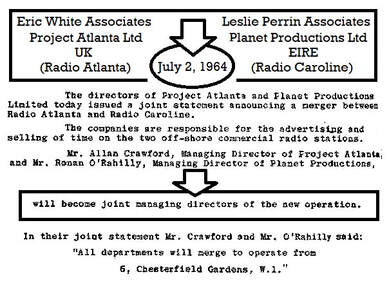 On July 2, 1964 a joint press release was issued in the name of two public relations firms: Eric White and Leslie Perrin. White and Perrin (who David Block worked for), claimed to be representing two different companies, one of which was British (Atlanta), and the other was based in Eire (Planet). Both companies were formed to sell time on two different radio stations. This joint press release for two different companies registered in two different countries, are each represented by a Managing Director: Crawford for Atlanta; O'Rahilly for Planet. This statement of fact is then followed by a statement of obfuscation. Both Crawford and O'Rahilly are to be joint managing directors of "the new operation".
Question: What is the name of "the new operation"? We are not told, but we are told that it will have "departments" and that "the new operation" will be located at: "6 Chesterfield Gardens, W.1. Since the press release is dealing with two different sales organizations based in two different countries it must have a name because it has an address, and it must be involved with more than sales since it has "departments". This is no idle matter. It is something that has been totally overlooked by the myriad of writers whose words attempted to tell their readers what the story of Radio Caroline was all about. Yet, no one seems to have addressed this very basic issue, even though it goes to the heart of the problem that suddenly confronted Ove Sjöström and George Saunders in September 1964, but which began at some point in time before that date. That being the case, then this Press Release that is dated July 2, 1964, reveals an omission that became a critical flaw in the operation of Radio Caroline North which first came on the air with entirely new equipment on March 27, 1964, and that flaw is answered by this question: Who installed the broadcasting equipment on board the mv Caroline? 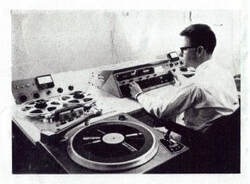 Einar Zeth Olov Sjöström, was born in 1938 and became known as SMØXBI Seth Sjoestroem during his amateur radio transmissions. On Radio Caroline he became known as Ove Sjöström [shown left] where he was a Panel Operator aboard the mv Caroline (ex-Fredericia) which originally dropped anchor off Essex, England, and he stayed with the ship when it later moved off Ramsay, Isle of Man. Previously he had worked on board the mv Bon Jour off Sweden when it served as a radio ship for Radio Nord. When Nord closed down, Sjöström went to work in Liberia and then he returned to work on the mv Caroline. There is a lot of controversy concerning the time that Sjöström was with Radio Caroline. According to Sjöström, after Radio Nord closed down he had discussions with Allan James Crawford about a similar job on the ship then renamed as mv Magda Maria, and which in 1962 was anchored off Brightlingsea, Essex. This was after the incident in which the revived Swedish station called Radio Mercur aboard the ship Lucky Star, had been boarded. That news event scared-off the John Delaney Organization who supplied the theatrical business with goods and services, and they were Crawford's primary financial backer. Crawford then lost his mortgage on the THV Satellite from which Crawford had been planning a station called either Radio Atalanta or Radio Atlanta. That ship was docked at Cowes in the Isle of Wight. In 1962 the mv Magda Maria was anchored off Essex, and its Texan representative Bill Weaver was staying at the Mayfair Hotel in London where he was looking for a buyer. Among those he talked to was Allan Crawford. According to Sjöström, he was also talking to Crawford about a job on board the mv Magda Maria (ex-Bon Jour) in a similar capacity to the one he held for Radio Nord. Whatever really transpired, it led to Sjöström holding a grudge against Crawford and taking a job in Liberia. [See the various poorly translated documents from Swedish to English that are on file at http://www.bobleroi.co.uk/ScrapBook/CarolineRollCall/Ove%20Sj%F6st%F6m%20.pdf - which will be referred to later as 'Bobleroi-Sjöström'.] Ove Sjöström offers his own explanation on the link cited above, as to how he came to be working on board the mv Caroline (ex-Fredericia). We have nothing at the present time to refer to as an authentic source of verification for that information. By this we mean an independent and non-hearsay documented account. On board the mv Caroline, Sjöström was always shown as a 'Panel Operator', and not as a qualified radio transmitter engineer. (See the picture top-left.) A Panel Operator sat in a room in which the turntables and tape recorders were located. Facing a glass window, Sjöström could see the announcer in the adjoining room. During the first few months in the life of Radio Caroline, the announcer gave the introductions and visually signaled through the window to Sjöström who then played the record or tape. Radio Caroline began test broadcasts from the mv Caroline (ex-Fredericia) on March 27, 1964 from a position off the coast of Essex. On July 2, 1964, a formal announcement was issued jointly by two public relations agencies: Eric White Associates for Radio Atlanta, and Leslie Perrin Associates for Radio Caroline - who employed David Block. The context of their press release confirmed that Radio Atlanta would immediately become the home of Radio Caroline South and remain on station off the Essex coastline, while the original Radio Caroline would become Radio Caroline North and sail to take up anchorage off Ramsay, Isle of Man. Supposedly, prior to this time the two ship stations had been independent operations, when in reality Radio Caroline had been spun-off Radio Atlanta, and that behind both ventures was a common hand manipulating all events. For a variety of reasons, a 'mastermind' could not be shown in public which would have confirmed parts of the real story that British authorities already knew. The reason is simple: the entity that the 'mastermind' represented, held huge UK governmental contracts that this entity would be in danger of losing! However, in 1964, there never was a company called 'Radio Caroline', and neither was there any solid evidence to show the connecting dots to the person who was ultimately manipulating all events. There were many tell-tale signs, and from an early stage a lot of the ambiguity had already been deciphered by persons such as the Director General of the British Broadcasting Corporation, and by the General Post Office. The GPO issued all British broadcasting licences on behalf of the British Crown corporation sole, and the Crown holds the right to sovereignty in the British Isles. Its powers are administered by its civil servants and Privy Councilors. (The Crown should not be confused with the Queen as an individual, because she 'merely' represents the public 'face' of the Crown corporation sole.) In theory, Radio Atlanta and Radio Caroline had been two separate organizations, but that apparent separation was an illusion. To conceal the obfuscated fact that Atlanta and Caroline were one operation, with Caroline being introduced to effectively allow Atlanta to succeed, a 'common hand' had taken hold of Atlanta, and then this same 'common hand' had created Caroline. This is the 'mastermind' I referred to earlier. Because the original Atlanta operation had Australian Allan James Crawford as its figurehead, he was promoted in the press by the Australian Public Relations firm of Eric White and Associates. When the 'common hand' then created Radio Caroline, it was necessary to also name a titular corresponding head of its operations. Thus, Leslie Perrin and Associates who employed David Block, were employed to begin promoting the name of Ronan O'Rahilly as the managing director of Radio Caroline. The problem with all of this PR promotion was that there was no such company as Radio Atlanta, nor was there a Radio Caroline company. So neither Crawford nor O'Rahilly could manage directors - because there were no directors to manage! What did exist was a version of the original blueprint used to create commercial television operations in the United Kingdom. The only TV company, apart from the BBC, which was licensed by the Crown via the GPO to broadcast in the United Kingdom, was a State chartered operation called the Independent Television Authority. ITA was primarily the result of the same 'mastermind' that was behind the Atlanta-Caroline model for promotional commercial radio broadcasting. ITA controlled all transmitters and it broadcast its own test cards and accompanying sounds. But ITA sold-off its entire airtime by regions, so that it effectively became what the USA radio and television broadcasters called a sponsored broadcaster. But whereas in the USA, the stations controlled their own transmitters under federal license, and except where networks of relayed programming had been created, the U.S. Federal Communications Commission set a legal limit on the number of radio and television stations any single person or company could own. In the UK, the ITA station owned everything except for the BBC stations. However, ITA then leased off its entire broadcast day by region to program contractors, and they in turn created income by selling advertising time to other entities. Because the public mainly saw the names of these sponsored program contractors, the public began associating these names and logos with the transmissions and went so far as to refer to them as "ITV" or "Independent TeleVision". But "ITV" as a station concept would not arrive in the British Isles until decades after ITA had gone on the air. So the mystical Crawford and especially O'Rahilly were hailed by the joint PR release as twin 'Managing Directors" of an entity that did not exist. What had been created in August 1963, was a British program contractor called Project Atlanta Limited, and as late as February 1964, an Irish program contractor called Planet Productions Limited, that was not registered in the UK. Registration for a foreign company was required by UK law if that company was doing business in the UK. This would later become a problem for the phantom 'Radio Caroline'. Coupled with the press announcement and the renaming of Atlanta and the movement of the original Caroline to the Isle of Man, was the additional sleight of hand by creating an entity called 'Caroline House' in the heart of the wealthy Mayfair district of London. At this phantom location, Crawford and O'Rahilly supposedly managed the operations of Radio Caroline South and North. But when a major problem came up in September 1964 relating to the physical operation of Radio Caroline North on board the mv Caroline, the solution did not come from a phantom Radio Caroline company, instead it came from elements that had been associated with Radio Atlanta! This is where controversy begins to expose the total fraud perpetrated in order to conceal the real 'mastermind' and true purpose of Radio Caroline. This is what we will begin to deal with in part 3 of this story tomorrow.  David Block described the equipment installed on board the mv Caroline by category, and he identified it as the work of Arthur Carrington. Under the sub-heading of 'generators', Block wrote that there were ".... two generating sets, made by Mercedes-Benz, each capable of delivering 80 kilowatts at 220 volts (3 phase). A control panel regulates the voltage with a complicated switch gear." It is this seemingly innocuous paragraph that
later became the center of a dispute involving Ove Sjöström and George Saunders. An air of mystery was also created regarding the identity or even authenticity of Arthur Carrington as a real person. No pictures were ever issued regarding this important individual who, according to David Block, turned a ferry boat into a radio ship, all by himself. Because this incident goes to the heart and core of who was really behind the creation of Radio Caroline, we will deal with the CV of Arthur Carrington as a later and separate Blog entry. Here we will deal with the issue of the installation of the equipment itself. Having read Block's version involving Carrington's participation, tomorrow we will address the claims of Ove Sjöström. I had to modify yesterday's blog entry when some of the information I was working with began to conflict with other documents that I was about to draw upon.
This is a cold case investigation which enables a researcher to have an overview on all of the evidence collected to date. A topical story allows the writer to only review the information previously collected within the space of a horizontal time frame, and the writer then has to meet a related deadline for publication. But this story is decades old, and therefore this analytical overview can inspect information placed within folders and files during a vertical time frame, with only a self-imposed deadline. When I was writing yesterday about David Block's account of Arthur Carrington, it was within a horizontal time frame, but the information I began to refer to came from a later period within a vertical time frame. That is when a controversy arose in my mind concerning the account of Arthur Carrington as written by David Block. Part of that controversy was stimulated by the account published out of time sequence by Ove Sjöström, which was in itself challenged by the account created out of time sequence by George Saunders regarding Ove Sjöström. Those two accounts also conflicted with the David Block account of Arthur Carrington. This creates an additional problem for me. No longer is it sufficient for me to just trace the career of Arthur Carrington, but it is also necessary to trace the career of David Block and discover where those two lives collide with each other. It is not only necessary to know who Arthur Carrington is and who he worked for, but I also have to know who David Block is and who he worked for, because it is Block who introduced Carrington. But, when the comments of both Ove Sjöström and George Saunders are added to the mix, there is at least a four-way ball of confusion. "At least four-way", because there is also contemporary documentation that supports, in part, some of Saunders account. But the account by Sjöström weaves a tangled web around both Allan James Crawford, and the Texas owners of 'Radio Nord' where Sjöström once worked. Given all of that, I need to find the other folders within vertical files and place them for analysis side-by-side and within the context of horizontal events. In that way I can then perform a closer examination and hope to discover just where the truth resides. That is what I hope to present in this Blog tomorrow. The person shown in the picture at the bottom of the page is not Arthur Carrington. It is the photograph of Swedish 'Panel Operator' Ove Sjöström. According to former Marconi engineer George Saunders, a few months after the mv Caroline moved to a new location off the Isle of Man, he was sent to the ship in order to sack this same individual. Saunders claims that Sjöström had rendered one of the new CE transmitters useless, and that Sjöström was on his way to destroying the second one. That of course would have put the original Radio Caroline, now designated as the 'North' station, off the air! However, because it is this same textual controversy which envelopes both Sjöström and Saunders, I will spend more time examining it in depth within tomorrow's Blog. According to David Block, Arthur Carrington not only "installed the equipment", but this man whose picture is not shown, was also "responsible for Britain's first aerial and first undersea television transmissions. He also worked on the installation of equipment into the Manchester studios of ABC Television and has worked for the BBC, The Marconi Company [sic] and for the British Government on radar." But David Block does not want there to be any ambiguity as to what he meant when he wrote that Arthur Carrington had "installed the equipment", because he then continued to list the "equipment" that he was referring to with these words which appear on the following page. Generators. Block says that Carrington installed: ".... two generating sets, made by Mercedes-Benz, each capable of delivering 80 kilowatts at 220 volts (3 phase). A control panel regulates the voltage with a complicated switch gear."
Now this raises a question about the truthfulness of David Block, and the controversy involving Sjöström and Saunders which I will address tomorrow. Let look at the next item of "equipment" that Carrington is alleged to have installed: Transmitters and Combining Unit. It refers to ".... two transmitters and a combining unit all manufactured by American Continental Electrics [sic]. ..... The combining unit was put into operation at the end of May [1964] ...." The transmitters were manufactured in Dallas, Texas by a company called Continental Electronics, not 'American Continental Electrics'. This technical slip seems to point to David Block not being on the ship, nor having actual documents to work from, being given second-hand notes by someone, which raises questions about the person who wrote his notes, and who he was working for when he wrote his own text? However, irrespective of the manufacturer's name, those transmitters were installed at Rotterdam, and not at Greenore. They were already on board the mv Caroline when it first arrived in Ireland. The next item attributed to Carrington is the aerial. Now Block contradicts himself, because he says that it was "designed and manufactured in Southampton and rigged in Cowes in the Isle of Wight." Now we know for a fact that Arthur Carrington did not design and nor did he manufacture or rig the aerial (antenna), because we know who designed it and who manufactured it, and neither party was named Arthur Carrington. Now as for "rigging" the antenna, well it could not be "rigged" before a mast was erected on the mv Caroline for the antenna to be rigged to, and the mast was erected at Greenore. Finally this "equipment" section refers to 'Sound Control Room and Studio', and according to Sjöström, who was the Panel Operator from Sweden, some of this work was carried out by him, and his Swedish colleague. So who is Arthur Carrington? He is the person that David Block so conveniently identified as being the person responsible for turning the entire mv Caroline into a radio broadcasting ship. More on this tomorrow. Readers are told that this item was attached in "Southern Ireland", meaning the Republic of Ireland, to stop a needle from sliding across records during a storm. Prior to this information he has slipped in these key words: ".... where she was fitted out for broadcasting". It is as if David Block senses that information about the stability of the vessel is more important to listeners than details about the broadcasting station on board the vessel.
Who installed it? Who paid for it to be installed, and who owns the ship that it was installed upon? David Block does not tell us. Instead, David Block delights in telling readers on page 9 all about "28 year old Don Murrison" who works for "Anglia Marine Agencies of Harwich" who supply the ship after getting permission from a lot of UK governmental entities. There is even a big picture of the ship's cook! But what did that statement ".... where she was fitted out for broadcasting" mean on page 8; the one wrapped around details of the ship's anchor? When the ship arrived at Greenore from Rotterdam in Holland, there were two 10kW Continental Electronics transmitters which had been manufactured in Dallas, Texas already on board the ship. How did they get from Dallas to Rotterdam, and who paid for their manufacture and transportation? However, whoever was behind Radio Caroline did not tell Christopher Moore. It was a secret. 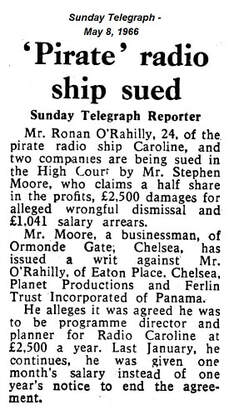 Chris Moore filed suit against the people that he thought were running Radio Caroline, and this newspaper cutting was the result. In May 1966, it must have finally dawned on Chris Moore that what he thought he knew about Radio Caroline, was nothing at all. This press cutting tells his tale. However, as time went on Chris Moore was placated and he must have withdrawn his law because he later appeared on an Arena BBC-TV program where he laughed about those days. So was he paid-off, and if he was paid-off, who paid him off, and why? Clearly no one was in a hurry to tell the press who had really set-up Radio Caroline, and later, when Ronan O'Rahilly tried to revive Radio Caroline with the help of John Bloom, he did not know where to start.  The next panel on page 6 introduces Simon Dee as a Canadian who was born in Ottawa, except that his name is Cyril Nicholas Henty-Dodd and he was really born in Manchester, England. David Block also tells his readers that Simon Dee met Ronan O'Rahilly at the 'Scene Club', even though the biography of Simon Dee says that they met during casual lessons held within paid classes for would-be actors. Carl Conway is yet another person whose life and times have become obfuscated. Then on page 7, we are introduced to Doug Kerr, and about the only pattern that is beginning to emerge is a prior connection to ITA program contractors.
Next comes Tom Lodge who came in via Chris Moore, who obviously knew nothing about the real story behind Radio Caroline. Tom Lodge is followed by Gerry Duncan who is the "Programme Producer", and he also came in with a background working for ITA program contractors. He was also brought in via Chris Moore, and it was Chris Moor's lawsuit that claimed that he was the the "Programme Director and Planner" for Radio Caroline. In other words pages 6 and 7 contain pictures accompanied by text that us nothing at all about the original on-air staff who were hired to present Radio Caroline programs, and neither does it explain who was behind Radio Caroline. This form of justification for Radio Caroline is extremely misleading because it is not an accurate account of the origination of commercial broadcasting as heard in the British Isles, but both the purpose of David Block's editorial, and Radio Caroline itself, was to promote a political message soliciting support.
On page 5 the key word is "some", as in "Some of the people involved". Right under this heading is a picture of Ronan O'Rahilly. In fact, his image is the only picture on page 5 of this original booklet. It then makes a very bold claim that is 100% untrue, as written: "Ronan is the young man responsible for Radio Caroline". Because if this sentence had been continued to state a true interpretation, it would have added: "becoming obscured as to its true origins and purpose". The next sentence as written by Block is also misleading, and it is open to interpretation because Block claimed that Ronan's father is Irish; even though Ronan's father was born at Hove in England. Block uses this link to Ireland as a means of introducing an obscure figure from Ireland's 'recent' past, who was part of a failed uprising against the British Crown. Constant embellishments to the story about this person have created a modernistic reevaluation of his historical importance, and the sole purpose of these revisions has been to provide Ronan O'Rahilly, who was a young man of 24, with a notable political past, when his political past is a void in annals of time. While Block identifies Ronan O'Rahilly's mother as "American" to correctly imply that she is a U.S. citizen; he then ignores the fact that his father was born in England and claims that "Aodogen O'Rahilly is an Irish industrialist who owns the port of Greenore where Caroline was fitted out for broadcasting." This statement also requires a lot of qualification because Ronan's father had bought a disused railway terminal that adjoined the water's edge where, at one time, a ferry docked and was serviced by H.M. Customs officers prior to Irish independence, and then for a time, it was serviced by Irish Customs officers. Ronan's father did not own a port, as such. But to even claim that Ronan's father had bought the land and facilities once used as a railway terminal complete with its own hotel that had served as a port, is also untrue. Ronan's father controlled a building materials company near Dublin, and that company had bought the land and derelict facilities at Greenore at auction, with a view to demolishing them; clearing the rubble, and then erecting both a new factory and truck loading facility on that site. But since the company controlled by Ronan's father was short of cash, it could initially only afford to buy part of the facility at auction (sans hotel building), and then it was all left to sit, 'as is', in a derelict state. Now the part of Block's rendition in which he states that: "Caroline was fitted out for broadcasting", is also untrue. The ship called 'Fredericia' and for a short time 'Iseult' and then 'Caroline', had been a ferry boat retired to Copenhagen. Then it was bought and brought to Rotterdam, Holland by the Wijsmuller company. That is where the ship remained for about as long as it later remained at Greenore. When the vessel arrived at Greenore, the two new Continental Electronics transmitters were already on board, and so was a new generator to power them. What had not been added was a mast to support an antenna, and a radio studio, comprised of both an announcer's booth and an adjoining room visually connected by a glass panel where a panel operator played the records on cue from the announcer's signal. Block then claimed that "Ronan had been in England since 1960 ...", but others claim that he "moved to London in 1961" [OEM 200; p.9, and on p.10 it says that "Ronan O'Rahilly's first few years in London are a little unclear, and many reports appear exaggerated, to say the least." The reason they are unclear is because they are full of faked reports designed to turn Ronan O'Rahilly into something more than a flamboyant gabber; which will be revealed both in this Blog, and later entries to prove that Ronan O'Rahilly was a fraud! So Block claims that Ronan O'Rahilly showed-up in England "since" 1960", while OEM claims that "he moved to London in 1961." Since London is the capital of England, it would seem that one of those reports is incorrect. Block says "since 1960" and OEM says "moved to London in 1961". If OEM had used the terminology of Block, then the two versions might be compatible, but they are not. I want to remind readers that we are YesterTecs using cold case hard evidence to prove our assertions to court room standards where the "whole truth" and not "part truth" is demanded, and in a court room, failure to meet those standards can result in charges of perjury. Block claims that Ronan O'Rahilly "....founded the Scene Club in London, now [1964] acknowledged as the country's Mecca of rhythm and blues." But is that a true statement of fact, or is it more blarney that was later inserted to mislead everyone into thinking that Ronan O'Rahilly was someone he was not? We can begin by asking what the word "Mecca" means when used in this context by Block. The Cambridge Dictionary defines the word "Mecca" when identified by a capital 'M' as ".... the holy city of Islam in Saudi Arabia", which the 'Scene Club' clearly was not. When a lower case 'm' is used, the same source defines that word as: "a place to which many people are attracted." Clearly this is the meaning that Block intended to convey, but therein is an other problem because Block claimed that it was a comparable shrine to the Holy City, only this shrine was to rhythm and blues music. But is that convoluted statement true? Well, first of all 'The Scene' was not "founded by" Ronan O'Rahilly. How do we know? Because we have already researched this topic and we will reveal our documentation in another day's Blog. But more than that, 'The Scene' was not even the premier destination for rhythm and blues music. How do we know that? The answer is contained in the contemporary music pages devoted to club advertising. 'The Scene' was a poor man's attempt to cash in on a fad which lasted for a very short time. Yes, we can prove that too. I don't mean that rhythm and blues lasted for a short time, because it morphed into a long-running style of music that is still enjoyed today, but the way in which it was marketed back in the early Sixties, well, it came and went within a short period of time. Block continues: "Ronan started the mammoth task of creating Radio Caroline over a year and a half ago. He controlled the operation from its beginning and has been the man 'at the helm' ever since." Now that statement contains a lot of problems. For Ronan to have begun to create Radio Caroline "over a year and a half ago", means that that he would have begun at the beginning of 1963, because Block's words were published almost half-way in the year 1964, and counting back in time would confirm the account by Allan James Crawford. [See our video at http://radiocaroline.info to hear it from Crawford himself.] But Block is trying to deceive us when he then claims that: "Ronan started the mammoth task of creating Radio Caroline over a year and a half ago. He controlled the operation from its beginning and has been the man 'at the helm' ever since." First of all Crawford contradicts O'Rahilly, because Crawford claims that O'Rahilly got his information from Crawford. However, Crawford is not telling the truth either, because Crawford tries to pretend that he began the project in 1963 with the ship variously called 'Bon Jour'; 'Magda Maria' and 'Mi Amigo', when in fact he had tried in 1962 to get a venture seaborne with a vessel called 'Satellite'. Furthermore, Jocelyn Stevens then contradicts Block, and he also does it on film in a Granada TV news show called 'World in Action'. Stevens clearly identifies the start-up of Radio Caroline as being sometime around September-October of 1963, and while Stevens attempts to disguise this fact, he does so in the presence of both Ian Cowper Ross and Ronan O'Rahilly who tries to pretend that he began the venture after going to Stockholm, Sweden to see the people behind the offshore station 'Radio Nord'. The problem with that lie is that in September 1962, the mv Magda Maria which had been home to Radio Nord, was sitting off Brightlingsea, Essex and its representative was staying at a hotel in London and trying to sell it to Allan James Crawford who lacked the money to buy it. Then Bill Weaver who was the Texan representing the ship in London - after personally closing down the venture in Stockholm - was asked by US Attorney General Robert F. Kennedy to bring the ship to the USA for a clandestine CIA venture. So Ronan O'Rahilly did not go to Stockholm, instead he went to Houston, Texas to see Bill Weaver, and he did so on behalf of Allan James Crawford! It seems that Block and O'Rahilly were involved in a cover-up, but the question is: for whom? More tomorrow! 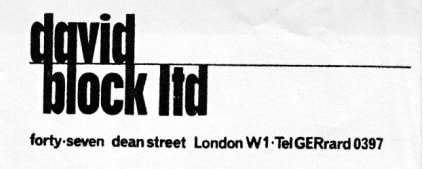 Radio Caroline came to the attention of the press, not by the actions of Ronan O'Rahilly, but those of David Block. It was David Block who wrote the first Radio Caroline brochure and skewed its text to obfuscate the real story about not only Arthur Carrington, but a number of other people as well. His boss was a very important person in the media world of music. Tomorrow, rather than following a scatter-gun approach, we will begin by focussing upon aspects of the first official Radio Caroline publication; analyze its contents, and expand upon them. To start the slideshow, highlight an image and then click the 'Play' button that will then appear top-left, and read our continuing commentary below each image .... 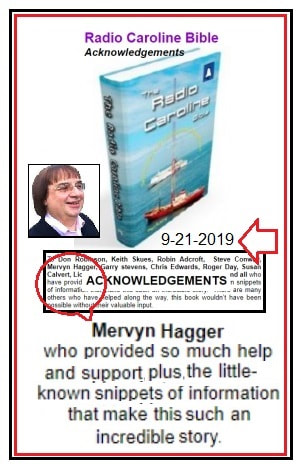 Last year, before Paul Rusling decided to betray a friendship and steal some of our research and then publish a garbled version of it under his own name and call it 'The Radio Caroline Bible', a member of 'The Trio' participated on a Forum about offshore radio. The person running that Forum made our member an Administrator of his Board, while he also dumped the trolls who were also on his Forum. He called them members of "The Church of Caroline". Central to their belief system is a myth that Ronan O'Rahilly was the creator of Radio Caroline. Right now I won't reproduce the private emails that the owner of that Forum sent to us, but I will point out that Paul Rusling is an Administrator of that Forum upon which is an advertisement for his fake story. That site is now populated mainly by gullible trolls who hide behind 'user names'; many with multiple fake identities. The reason for mentioning this now, has to do with my last post on this Blog, and one prior to that in which I explained why we are known as 'YesterTecs'. It is because we try to follow a synthesized formula of academic research and "good old-fashioned police detective work" as the basis for our own investigations. 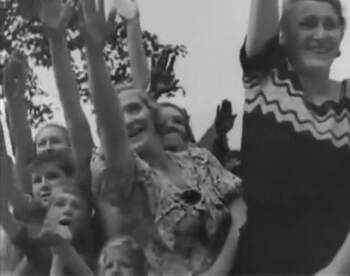 One of the foundational problems that we have encountered is something that Joseph Goebells came to understand in aiding and abetting the German National Socialists (Nazis) to establish their grip on the human mindset. In many instances that grip was achieved by young people with young women being to the fore. To see what I mean about hero worship, just watch the 1935 Nazi movie called 'Triumph of the Will' (English title), which is available online at: https://www.dailymotion.com/video/x6uajey 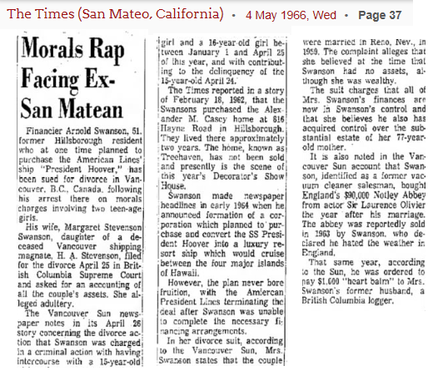 As with all fake propaganda it is usually surrounded at the edges by a degree of fact, and that is what makes it believable - to some. Metropolitan Police were convinced that Arnold Swanson's GBOK was a fake scheme by a confidence trickster to solicit money from investors. Swanson led would-be financial backers into thinking that he had money previously made by him from being the inventor of the car seat belt, among other things. In reality, Swanson was a former vacuum cleaner salesman who married a lady from Vancouver, British Columbia, Canada, whose father had died and left her a fortune he made from a shipping line. Swanson's wife eventually divorced and exposed him after he was exposed in court for having sex with underage girls. Therefore in trying to expose how Radio Caroline sprang to life on March 27, 1964, it is necessary to explain what actually happened, and not what everyone has been led to believe had happened. This is the reason for going back in time to see how Ronan O'Rahilly was promoted by the press as the creator of Radio Caroline. The mythology has been repeated so often over the years that now we are well beyond the first generation that began spinning his lies and deceit. Not only is Ronan O'Rahilly now dead, but so is the Pye Group of companies that he was really working for in those early days. 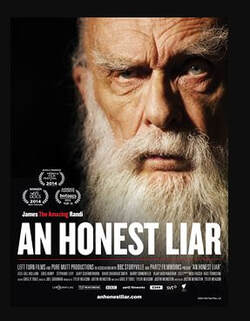 In addition to 'Triumph of the Will', you should also watch 'An Honest Liar', which is a 2014 documentary about James Randi. He was a former magician and escape artist that began investigating fake claims by so-called psychics; faith healers, and con-artists. No matter how many times the fraudsters are exposed, the masses continue to believe them. The same is true of the fraudsters behind 'The Church of Caroline' who con gullible trolls to support it with their money, time and contributory labor. Therefore we will now proceed to take apart the various elements and people who brought Ronan O'Rahilly to the attention of the mass media as the false messiah behind the creation of Radio Caroline. "O, what a tangled web we weave, When first we practice to deceive!"
That is a quotation from Sir Walter Scott. Scott was very good at inventing history that never happened, and David Block must have attended his school of thought, because either David Block was told to distort real events, or David Block who wrote the first Radio Caroline booklet had no idea of what the real story was. But we do! While Block was writing about contemporary events that had taken place only a few months earlier, the actual events that he was referring to were shrouded in secrecy, and there is nothing in the writings of Harry Spencer to suggest that David Block was present the day that Harry Spencer showed up at 47 Dean Street. This is important because Harry Spencer relates an event that must have taken place during the first part of January 1964, and we conclude this from the references that Harry Spencer made in his recital. One key to the date is found in Harry Spencer's timeline of events resulting from that meeting. By following his thread we are led to the arrival, or rather, the non-arrival date of the mv Mi Amigo at El Ferrol, Spain, following its original port of departure from Galveston Island, Texas. Spencer says that he went to 47 Dean Street after Allan Crawford had made the most recent in a string of telephone calls to him. The originating purpose of those calls was moot by the time that Spencer did arrive at 47 Dean Street, because Crawford want to to discuss fitting a new mast to the THV Satellite, which Crawford no longer owned via a ship's mortgage. Whatever, Crawford wanted to discuss, it was not the THV Satellite which had been docked at a port on the Isle of Wight where Spencer maintained his own business. Spencer recites how he walked into 47 Dean Street and encountered Alfred Nicholas Thomas. Thomas had made a career out of transmitter engineering with the BBC from which he retired in 1959 after which he went to work for the Pye Group of companies. This was verified in his obituary published by the BBC staff magazine. It contained comments from several people who had known him, but his BBC employment and his later work for Pye were not the only references. It was acknowledged that Thomas had also gone to work for at least one offshore radio project. From other sources we know that Thomas visited the offices of CNBC on Dean Street, and then went on board the Borkum Riff anchored off Holland which was home to VRON, an offshore station that became known as Radio Veronica. It was not a happy experience for Thomas. Since VRON/Veronica was short of money, there is enough evidence to show that his employment by Pye, and his subsequent deep involvement in offshore broadcasting, was not an activity that Thomas took on by himself. His employer was Pye. Thomas then cropped-up in connection with the spin-off GBOK project of Arnold Swanson who Metropolitan Police had deemed to be a con man, a swindler, and whose ultimate goal was not offshore broadcasting, but absconding with investment money. That had also been the downfall of the CNBC venture. Swanson ultimately left the UK with his wife who was the heir of a shipping company fortune bequeathed by her deceased father in Vancouver, Canada. Swanson's wife ultimately divorced him and revealed that he had been a vacuum cleaner salesman when she met him, and was going to prison for underage sex when she divorced him. Swanson had come on to the scene like Ronan O'Rahilly, surrounded with fanciful tales which included inventing car seat belts and all kinds of other wonderful accomplishments, which according to his wife, were all bogus. But Swanson managed to get his wife to buy an impressive property in England, and then he managed to ingratiate himself with John Thompson of Slough who had also spent time in Canada as a journalist. It was Thompson who made the first splash in the press - including the Canadian press - about starting a British offshore radio station. At the time one major British firm was registering a string of companies that all began with 'Voice of ....', and were part of the momentum to secure licensed land-based sponsored commercial radio stations. In the end there were nearly 200 of them, but their hopes were eventually dashed, first by Pilkington, and then by the General Election result of October 15, 1964 when Labour came to power. But in the early days Thompson pulled a rabbit out of his hat when he secured a 7 days a week contract from the Aldridge Brothers London advertising agency representing the British interests of Herbert W. Armstrong and his Radio Church of God, Inc. This church organisation was headquartered and registered in California, USA, as well as in London, UK where the church had just opened a second campus of its Ambassador College between Watford and St Albans in Hertfordshire. Swanson approached Thompson and sold himself as not just a wealthy man, but a technical expert who could transform Thompson's tiny 'Voice of Slough' station into something major that was based upon commercial formats used in North America. So the two joined forces. However, Swanson's flim-flam attracted the interests of Charles Orr Stanley and his son John Stanley who controlled the Pye Group of companies. Via a subsidiary of a subsidiary formed in December 1963, the Stanleys had incorporated an offshoot of Faraday Electronics at Sheerness. This company had originally been a radio-gramophone manufacturer, but when Pye took it over the company was changed from being a retail manufacturer to a manufacturer of technical instruments. This coincided with the sale of HM Dockyards at Sheerness and the subsequent purchase of a large building within that complex that also faced the quayside. Swanson eventually got hold of the former Irish lightship Lady Dixon and had it towed and docked alongside the Faraday facility. The Stanleys who had hired Alfred Nicholas Thomas then put him to work on the GBOK project. Working with Thomas was another retired BBC employee named John Howard Gilman, and one of his specialties was in antenna design. A third member of that technical group was Arthur Carrington who had been hired away from Marconi to work for Alpha Television, a company jointly owned by Associated TeleVision and ABC Weekend Television who were program contractors for the Independent Television Authority (ITA). Carrington's specialty was in television cameras and microwave networking, both of which were skills used by Alpha Television in which Pye had a major interest. Pye supplied a lot of television equipment, both transmitters and cameras to both BBC and ITA, and Pye also worked closely with the Gates corporation in the USA. In the end Swanson's own devious devices caused the collapse of GBOK, and for a time John Thompson tried to revive his original project by renaming his 'Voice of Slough' venture as GBLN. He even made an illegal land-based transmission from Slough and tried to fool everyone, including Armstrong, that his project was still going ahead. In the end Thompson redirected his attention to the former Maunsell Fort on Red Sands sandbar and the fledgling Radio Invicta. So when Spencer came through the door and shook hands with A.N. Thomas, he was shaking the hand of a man with a lot of offshore radio experiences under his belt, as well as a lifetime of work for the BBC, and the backing of the Pye Group of companies. Thomas grilled Spencer, according to Spencer's own account, and that grilling was resumed by meeting the next person: Captain De Jong Lanau, Chief Superintendent of Wijsmuller Tug and Towing company based in Baarn, Holland. With the Captain was a very young Ronan O'Rahilly, which means that before anything had taken place, O'Rahilly was working with Crawford in January 1964, and, he had previously been sent to Houston, Texas in June 1963, by Allan Crawford. A little later all of the announcing staff (including Simon Dee) who were used for the venture that became known as 'Radio Caroline', were all trained by Crawford's fellow Australians, upstairs in Crawford's studio at 47 Dean Street. More tomorrow when I will tell you more about David Block and Arthur Carrington and how we were able to discover aspects of his life and reassemble his CV which went from Marconi to the Pye umbrella! I have been asked why I don't simply tell the story from beginning to end in a linear manner without dancing all over the place? It is a reasonable question that deserves a reasonable answer, and here it is:
Using my current theme on this Blog which relates to the meeting of Harry Spencer at 47 Dean Street in circa. January 1964, my 'dance' begins with an explanation of what exactly is meant by the word linear: It is defined by one dictionary as referring to events "arranged in or extending along a straight or nearly straight line: a linear movement"; and as events "progressing from one stage to another in a single series of steps; sequential." But to accomplish a linear storyline means knowing all of the facts, or even explaining what we as a team now know, or are still uncovering, is why our version of events differs from the accepted version of events. The trouble is, we are still uncovering the real storyline and this provokes questions due to its contradictions of what is claimed to be true, versus what is true. This Blog began as a reply to plagiarism from someone who took our research and grafted it onto the accepted mythology and made the confusion worse than it was. Then came criticism from trolls who had read the mountain of books and other publications about Ronan O'Rahilly, who we maintain was a fraud, and who some seem to worship as a messiah or even a god. Now that we have shut out the trolls by blocking their barrage of cyber-stalking posts, we are proceeding at our own original pace as 'YesterTecs'. We adopted that term to describe our own activities that set our findings apart from the writings of so-called 'historians' who claim to have documented the history of offshore broadcasting. Most of them have failed miserably because they were deliberately led astray by Ronan O'Rahilly and his masters. O'Rahilly was a puppet on their string and the historians have fallen for his lies and distortions. Because we do not want to be classified as 'historians', we needed another word to describe our activities, and thus we became YesterTecs. YesterTecs are cold case detectives analyzing past events because no one else is doing so. YesterTecs review the hard evidence to see what has been missed, and that involves a dance in itself. Names crop up that others gloss over. To learn more about the people behind these names it is often necessary to buy books and documents from a variety of sources, and often we are only able to extract a paragraph or two. By documented I mean that sources are given by way of reference. We want to avoid hearsay. We also look for contemporary accounts and first hand recitals by people with first hand knowledge which can also be verified by other means. With 'live' criminal cases, detectives will often dance around in their questioning in order to keep a suspected person of interest on their toes, because it makes it more difficult for that person to remember what they just said, if they are repeatedly asked the same question out of sequence. With our cold case, it is the existing body of skeletal evidence that causes us to join in the dance, because the clues to the real story, and not the accepted story, do not come in a convenient linear format. To assist us in discovery, we borrowed the term 'O3X' from psychiatry, and then we combined its revision: 'E-O3X' or Event - Self, Time, Place', as our guide to cold case investigation. The 'Event' refers to an actual occurrence in time such as the arrival of Harry Spencer at 47 Dean Street. The 'Self' is this instance refers to Harry Spencer. The 'Time' refers to the date and time (which at present is not specifically known) when this occurred, and the 'Place' in this instance, refers to 47 Dean Street. Consequently, it depends upon which part of a thread we are tracking in terms of its relationship to the overall storyline, as to how it is then reported on this Blog. Now when all of the data has been sifted and analyzed, it will then be assembled into a linear storyline and that will appear in manuscript format. As far as we know, we are the only team using this methodology as our guide to solving what everyone else has deemed to be "case closed" now that Ronan O'Rahilly is dead. But since the biographical accounts of Ronan O'Rahilly have been composed of lies and distortions, this case is not closed and our own investigation continues. 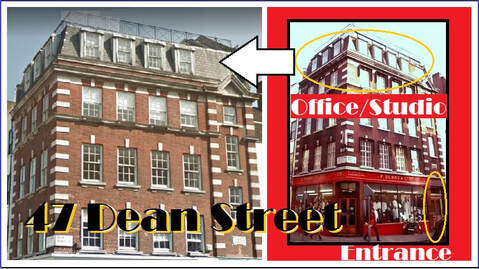 One reason we know for a certainty that Radio Atlanta and Radio Caroline were always one single project, is because of the meeting reported by Harry Spencer. It took place at 47 Dean Street in the Soho district of London. We do not know the exact date of this meeting because Harry Spencer did not tell us. But we do know from related events that it was most probably in the first half of January 1964, and we also know why Harry Spencer went to that meeting. Not only that, but Harry Spencer also told us who else was in attendance, and therein is a key to unlocking the mystery of how Radio Caroline came into existence. 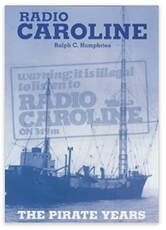 The location of Harry Spencer's revelation begins on page 181 in Appendix One: "Harry's Story", which is part of the 2003, and revised/updated book published in 2018 by Ralph C. Humphries called 'Radio Caroline'. While other parts of the book repeat myths found in the accepted story-line about Radio Caroline, I should explain that Ralph worked for Trinity House, but that was years after the events described by Harry Spencer, whose account seems to be his own authentic rendition. We know that 47 Dean Street was not Allan Crawford's first office after leaving Peer-Southern, but it was his home for not only Merit Music, but a string of other companies that he was involved in which also shared his address. Harry Spencer had received "about three or four" phone calls from Allan Crawford who wanted "to talk about a big mast for a weather ship". That "weather ship" had been owned and operated by Trinity House with the name 'Satellite'. 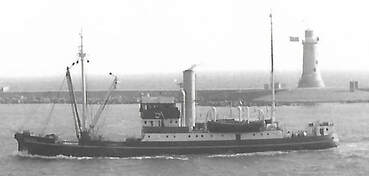 The THV Satellite had been retired to a berth at Cowes on the Isle of Wight where Harry Spencer's workshop for rigging ships, was also located. Crawford had obtained a mortgage to buy the 'Satellite', but prior to actually meeting with Spencer, events had taken place off the coast of Denmark which caused Crawford's main investor who owned a theatrical group of support companies called the John Delaney Organization, to withdraw his financial backing from Crawford. 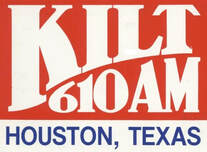 By 1962 Bill Weaver who was the national station manager for the McLendon stations based in Dallas, Texas, and the Station Manager of McLendon's KILT in Houston, Texas, had acquired another responsibility. He had been instructed to go to Stockholm and close down McLendon's offshore station called Radio Nord, and then to sell it. In 1962, Bill Weaver moved into the Mayfair Hotel in London from where he talked to everyone and anyone who might have had an interest in buying the offshore radio ship 'Magda Maria', which also carried a cargo of equipment from its former Stockholm studio, that was now packed into the cabins below deck. Meanwhile the ship remained anchored off Brightlingsea, Essex. Weaver spoke with the owners of Radio Veronica who went out to inspect the 'Magda Maria' under the watchful and reporting eyes of H.M. Customs. But Weaver did not get a sale. He talked to Arnold Swanson, a con man behind the GBOK project with its proposed radio ship called 'Lady Dixon', but he got nowhere with that lead either. He visited with Allan Crawford who was interested, but having just lost his financial backer, Crawford lacked the money to buy the 'Magda Maria' and its cargo. Then in September 1962 Robert F. Kennedy came calling via his friend Robert Thompson, who had been the spokesman for Gordon McLendon and Clint Murchison in the 'Radio Nord' venture. So Thompson told Weaver to get the ship ready for a transatlantic crossing and bring it to the Texas island of Galveston. It would then be converted into a propaganda ship using helium balloons in the secret and ongoing CIA war led by Bobby Kennedy against Fidel Castro's Cuba. 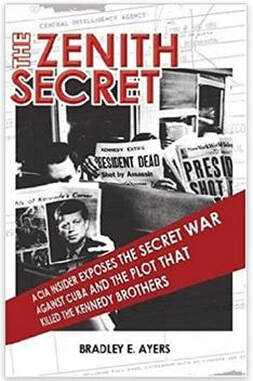 That war was being run from the facilities of a CIA operations center situated on the southern campus of the University of Miami, and it was disguised as a private research company leasing space from the university. But right at the moment when the dry docking of the 'Magda Maria' was to make it seaworthy to cross the Atlantic Ocean, a near nuclear WWIII primer began an event that became known as the 'Cuban Missile Crisis. With the U.S. Navy blocking all sea lanes around the Gulf of Mexico - which was the entry point to Galveston from the Atlantic - the sea voyage of the 'Magda Maria' was postponed until the first part of following year. The ship also had to wait for the worst part of the Atlantic winter storms to pass before it made its voyage to dock at Galveston. The ship arrived in March 1963 and Weaver was on hand to supervise the stripping of all of its radio equipment. It had been intended to install helium balloons on board the renamed 'Mi Amgio', and after sailing into the Caribbean, it would have released high altitude balloons that were timed to drop propaganda over the island of Cuba. In the end, the 'Mi Amigo' was found to be too small for the job, and then the same company that later equipped Laser with its helium supported antenna, was told to equip the CIA vessel 'Olga Patricia' instead. This was the same ship that later became home of 'Radio England' and 'Britain Radio' on behalf of Don Pierson in Eastland, Texas. Meanwhile, back in 1962, the GBOK offshore radio project had collapsed due to mismanagement and the activities of Arnold Swanson, who Metropolitan Police suspected of using GBOK as a confidence trick to swindle investors. One of the key investors was a company called Faraday at Sheerness where the 'Lady Dixon' was berthed. Faraday was controlled by the father and son team of Charles Orr Stanley and John Stanley who managed the Pye Group of group of companies. Charles Orr Stanley had become involved with the UK broadcasting scene before WWII. His interests continued through the War years and went into full gear as soon as victory dawned. Stanley pushed for sponsored commercial radio and television broadcasting stations to be licensed by the government. In 1946 he was pushing the idea of offshore radio broadcasting, if the UK Government would not license stations on land. One of his main spokesmen was John Profumo, but he also had a team composed of the former management staff from the defunct Radio Normandie. Stanley's ambitions had to be put on hold until the re-election of Winston Churchill as Prime Minister came about. Labour was dead-set against any form of commercial broadcasting. Churchill held a grudge against both the BBC and its former boss John Reith. It was Reith who banned Churchill from the BBC airwaves prior to WWII. So Churchill had turned to both Tory Leonard Plugge and his International Broadcasting Company stations, as well as to the shortwave stations based in the USA which could be heard in the United Kingdom. 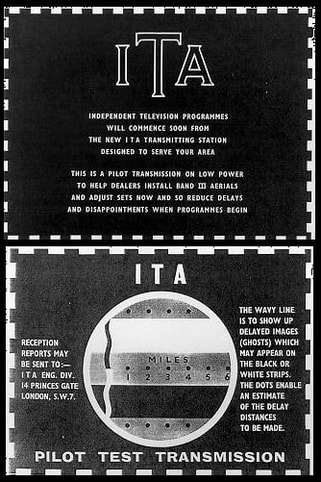 It was Churchill who then gave the green light for a new monopoly television station run by the government called the 'Independent Television Authority'. This sponsored commercial station with many transmitters, then leased all of its time, not in hours, or half-hours or quarter-hours like the USA stations, but zoned off areas and leased entire broadcast days to "program contractors" who then sold time to advertisers. Therefore by 1963, the Stanleys had both the money and the means to start a sponsored commercial radio operation, and that is how they came into the life of Allan James Crawford and the meeting described by Harry Spencer. But Pye did not fund the start-up of Radio Caroline. That money was brought in via several connections within the printing and publishing industry and coordinated by John Stanley. More on this continuing revelation tomorrow, when I will have a lot more to say, not only about David Block and Arthur Carrington, but I will also explain how and why Ronan O'Rahilly was brought in to deflect attention from what was really going on. While I was working on the Arthur Carrington follow-up, I noticed that a troll has outed himself and then had the chutzpah to accuse me of what "it" has decided to do.
Over on the forum for morons whose slogan is "Caroline lives matters" - which it doesn't because he trolls are worshiping something created out of a lie, one "Atlantisgb!" - has yet again tied itself to the blackmailing troll called Scottg, and it claims that I am Mervyn. Now that is interesting because the multi-named troll named "Atlantisgb!/Scottg", has now provided a convoluted explanation that another troll called "Maldonian" (none of these trolls dare to use their real names in their cyber-stalking), well that troll named "Maldonian" has insisted that I am me and that I have joined three other real people! Duh? So if I am me then I can't be Mervyn. but "Atlantisgb!" is "Scottg" - or is the politically incorrect "Atlantisgb!" really the slave-owning troll of another troll called "Scottg"? Clearly none of these trolls are interested in history, or the fact that the US Declaration of Independence tears into the British-German King George III - which is one reason why the North American colonies broke away from the British Crown - because your king promoted slavery and then tried to start a slave war. Well we have broken away from having anything to do with you monarchist trolls who populate the Garry Stevens Forum that started its own little petty war, which is why we are revealing the true history of Radio Caroline, right here, right now on this forum. We are a team of three and with me that makes four. Maybe that's too much "higher math" for troll minds? Well, one troll who has been trying to blackmail me into revealing information before I am ready to reveal it, adopted a tactic of claiming that because I wouldn't - that he would. So I dared him to go ahead, and then this nameless troll fell silent. I even offered to enter into a discourse with this troll, if he would simply identify himself. I made that offer several times and his response was silence. But he had one mission in mind and that was to support the theft of our work in a ridiculous book called 'The Radio Caroline Bible'. The problem for the thief who stole our work was that he was committed to upholding a lie; the myth; the hoax, that Radio Atlanta and Radio Caroline were two separate projects. The troll who cyber-stalked us supported this same ridiculous story - which becomes undone when the life and times of Arthur Carrington are revealed. The troll kept citing events in the professional career of Arthur Carrington which dated back to circa 1951, but he could not get enough material together to join that date to 1964 when Radio Caroline went on the air for the first time. The troll and his plagiarizing thief want everyone to believe that Ronan O'Rahilly created Radio Caroline, which he did not, and that Ronan O'Rahilly hired a radio engineer named Arthur Carrington to put the station together on board the ship renamed 'Caroline'. That simply did not happen, and here's why: The explanation is found in the first major piece of literature published in the name of Radio Caroline. It was a small booklet, and this is what it said:  A person named David Block claims to be the author of this 8-page booklet, but David seems to be unaware that "MV" stands for "motor vessel" (as opposed to "SS" or "steamship.) The ship was not a merchant vessel but a former Danish ferry, the one implying non-human cargo and the other implying the transportation of human beings. The picture of the person that David Block shows at the controls is not a disc jockey. In the early days Radio Caroline it only had announcers and panel operators, and that is what the person in the picture is doing. It is not a picture of Arthur Carrington, although by reading the text above the picture you might get the impression that is at the controls. The person shown is Ove Sjöström, panel operator who was also an amateur radio enthusiast. He was not a trained radio transmitter engineer. But because Sjöström misrepresented his credentials and almost destroyed both of the factory-fresh Continental Electronics transmitters on board the mv Caroline, George Saunders who is a qualified Marconi-BBC radio engineer, was eventually sent to the mv Caroline to sack Sjöström and repair the damage he had caused. But what of Arthur Carrington? In the booklet above it implies that Carrington outfitted the mv Caroline as a radio broadcasting ship, and it also states that he "was responsible for Britain's first aerial and first undersea television transmissions. He also worked on the installation of equipment into the Manchester studios of ABC television and has worked for the BBC and, The Marconi Company and for the British Government on radar." Is this true, or is David Block who wrote the text of this first Radio Caroline booklet, just making stuff up? Let's begin with what we do know. When the mv Caroline (ex-Iseult; ex-Fredericia), arrived at Greenore, in the Republic of Ireland, both the Continental Electronics transmitters and the electrical generator to power them, had already been installed in Rotterdam, Netherlands. That is where the Fredericia was originally berthed for about the same length of time it spent at Greenore, after it had been brought from Copenhagen, Denmark after completing its days as a passenger ferry. That being the case, the only thing to be installed was a radio studio which Ove Sjöström could accomplish. But what about the mast and the aerial (antenna) that was installed at Greenore? Who performed that work? The answer is Harry Spencer who was a qualified rigger based on the Isle of Wight. Spencer was at the initial group meeting before the mv Mi Amigo arrived at El Ferrol after leaving Galveston, Texas and making at least on stop at Sun Cay, in the Bahamas archipelago. Where was that meeting? At the office and studio of Allan James Crawford at 47 Dean Street, in Soho, London. Who else was present? Captain De Jong Lanau, Chief Superintendent of the Wijsmuller Towing Company who had Ronan O'Rahilly in tow. He was the second person that Spencer met that day after being greeted by A. N. Thomas. De Jong Lanau then told Spencer to follow him back to Rotterdam where the mv Fredericia was berthed. It was Spencer's job to construct masts for both the Fredericia and mv Mi Amigo after its transatlantic voyage. Before he left 47 Dean Street, Spencer discussed with Thomas the antenna that would be attached to what he at first thought was one mast on one ship. But Thomas did not design antennas, that was the job of his colleague, John Howard Gilman, who was not present. Both Thomas and Gilman were working for Charles and John Stanley who headed the Pye Group of companies. This crucial meeting was documented by Harry Spencer, but even though he did not place a day and a month on that event, it had to have occurred during the first half of January 1964, because of other known contemporaneous events. So where was Arthur Carrington? He was not present. But according to this booklet written by David Brock, the equipment that Arthur Carrington installed on the mv Caroline included two generators; two transmitters and a combining unit; the aerial and "the sound control room and studio." But that is contradicted by both Harry Spencer and George Saunders. We also know that Arthur Carrington was not a radio transmission engineer: he was a specialist in television cameras. But what of the other claims made in the name of Arthur Carrington, that he: ".... was responsible for Britain's first aerial and first undersea television transmissions. He also worked on the installation of equipment into the Manchester studios of ABC television and has worked for the BBC and, The Marconi Company and for the British Government on radar"? Well, David Block seems to have made a lot of stuff up, because tomorrow I will tell you more about those claims, and I will also reveal the working identity of David Block. Right now I am marking time on this Blog while everything gets moved into place following major discoveries of new information. These discoveries completely change the priorities of our own investigation. For this reason, it has been very easy to shrug off the trolls and to dismiss that entire brigade of noisy anorak radio celebrants who glorify a past that never was.
In the meantime, the introductory wording of this Blog has been reshuffled, and parts of it have been re-written. Adjacent linked sites are also being reorganized. At the moment, for the sake of preserving copyrights we have amended our priorities concerning the contents of this Blog. We have done so in the wake of suffering one major attack by a plagiarist, who was more of a smash-and-grab thief than an intelligent and premeditated robber of goods to order. However, this petty thief seems to have a tiny army of hard core trolls who will even stoop to blackmail by threatening to expose what they consider to be important information, if we do not bow down and join with them on their road to self-imposed lunacy. That road should not be confused with the disease of dementia even though it also robs human beings of their own identity. The trolls are lunatics because they are practicing self-harm by intentional ignorance. Therefore, not marching to their drumbeat, and being on the road to putting together a true account of past events that is composed of many academic disciplines, we will continue from now on at our own pace. But, we will continue, and we will be revealing a story-line that no one else seems to have figured out to date. 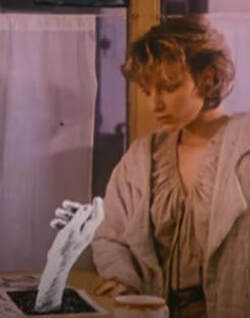 It wasn't a cartoon hand that came up and grabbed me, it was a family member, but I was pulled into a storyline to discover what was true and what was fake, sort of like this person in a cafe who is reading cartoon panels open on the table when one of the panels springs to life ... well, what would you do? A-ha! Great song, too! https://www.youtube.com/watch?v=djV11Xbc914 Our comments forum is now restricted to password only protection. If you wish to offer your own opinion on what you read here, it will be necessary for you to initially apply for access. This move became necessary when the trolls who do not believe in freedom of the press, but do support plagiarism and both lies and distortion, decided to overwhelm our comments forum with nonsense posts. We took a further step in making the forum invisible to anyone who is not a registered participant. Anyone can register, but troll posts will not be accepted and anyone violating the terms and conditions of the forum after being allowed to participate, will be removed from the access list. The further step in making the forum invisible to outsiders, is to protect the identity of anyone who wishes to assist us with our ongoing investigation.
We are now bringing all of our sites into conformity with each other, and this will involve quite a few changes and adding new content on some pages. We will return with the storyline about Arthur Carrington very shortly.
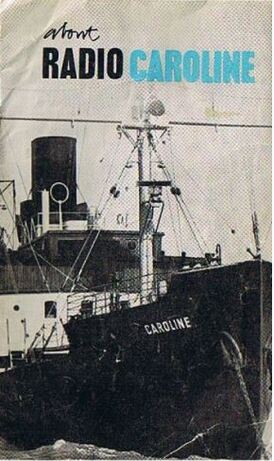 The deceit began before news of the first test transmissions on Friday, March 27, 1964 by Radio Caroline, ever hit the headlines. That deceit was carried forth in the very first brochure issued in the name of Radio Caroline. The deceit was planned, and although in retrospect it might seem that only a gullible few would believe that Radio Atlanta and Radio Caroline were two separate projects from two separate sources, the fact of the matter is that the gullible few turned into the gullible millions who still believe this myth today. It all began with the downfall of three projects: CNBC; GBOK and the original Radio Atlanta. Linking all three was a career radio engineer named Alfred Nicholas Thomas who retired after a lifetime of service to BBC transmitter engineering. After retiring in 1959, Thomas gained further employment by working on a series of radio projects for Charles Orr Stanley and his son John Stanley, who managed the Pye Group of companies. Almost from the start of his retirement, Thomas became involved with offshore radio by going on board the Dutch radio ship Borkum Riff where he tried to assist VRON; which became Radio Veronica. Aside from Dutch programming, its owners had plans to start an English language service called CNBC. Its office was was based in a building diagonally across Dean Street in the Soho district of London, and that is where Allan Crawford would later set up his independent record business. CNBC began test broadcasts, but then the plug was pulled by the Dutch owners, and CNBC was no more. From there, Thomas got involved with another spin-off offshore radio station. The original was named after its registered company, but the eponymous 'Voice of Slough', which copied a string of 'Voice of ....' station projects all waiting to get land-based licenses; also failed to get on the air. The 'Voice of Slough' merged with the attempts by a con man who was living off his heiress wife's inheritance, and he made a lot of noise with a project called GBOK and its intended home, the former lightship called 'Lady Dixon'. This hulk was eventually moved to Sheerness where Pye had bought part of the former H.M. Shipyard and moved a company that was renamed Faraday Electronics, to that site. Although press stories did connect Faraday to Pye, it was not a direct subsidiary of any one of the Pye Group of companies, and Thomas appears to have been working under its umbrella. But the GPO were watching Farraday and GBOK, and they were waiting for the moment to pounce in order to enforce provisions of the 1949 Wireless Telegraphy Act. The con man running the fraud behind GBOK, at least Metropolitan Police figured that the whole thing was a scam in order to bolt with investment money, was Arnold Swanson. Thomas and his former BBC antenna/transmitter engineering associate John Howard Gilman, obviously fell for the scam, and so did Pye. Because the legal infrastructure behind GBOK was poorly conceived, it enabled the GPO to move in and seize some equipment. It was enough of a disturbance all round to cause the GBOK project to collapse and for Pye to look elsewhere. It was also enough adverse publicity to cause Swanson to leave the British Isles. In Canada, this con man then engaged in under age sex, which resulted in both a divorce and prison time. Charles Orr Stanley had been involved with radio manufacturing since the 1930s, and after WWII he was one of the driving forces pushing for licensed sponsored commercial radio and television stations. Between the 1940s and the early 1960s, Charles Orr Stanley has continued to work on his plans to secure licenses for both radio and television sponsored commercial radio and television stations, but he was running into an Establishment split within the ruling Tory Party, where one half did not want to encourage further American involvement in British life. The Tory party was split on this issue. After WWII and his return to office following a defeat of the Labour Party and its rush to nationalize everything and anything, as the new Conservative Prime Minister, Churchill opened the door to licensed sponsored commercial television. However, the door remained firmly closed with regards to radio broadcasting, So Stanley began to play a two-sided game in which he only manifested himself on one side, while appearing to attack the other side. The 'other side' was offshore radio. Since CNBC; GBOK and then Allan Crawford had made so much noise in trying to get his first version of Radio Atlanta on the air, and failed, Stanley moved in behind the scenes. But Stanley then ran into another road block from Texas, on top of the failure to compromise by Allan Crawford. Crawford wanted to use the former Radio Nord ship which at that time was in Texas, to promote his independent record labels by broadcasting to London. Stanley wanted to broadcast to both the Isle of Man and to the Northwest of England. The reason being that Stanley had interest in two projects. One was originally called Radio Manx on the Isle of Man, and another one was called Radio Yorkshire based in Shipley. Clearly secrecy was going to be a key factor in this entirely complicated and divisive project, and so another ship was acquired to become the guinea pig that would discover just how far the UK government would go in closing down the entire venture. I will tell you more tomorrow, which is when I will also reveal how and why the first literature issued in the name of Radio Caroline during 1964, was a big part in a cat and mouse game in which the final objective was not to end up running an offshore broadcasting station! I will explain what the Pye Plan was, and I will also explain how Arthur Carrington became a part of this scheme, and why it ultimately failed on October 15, 1964. |
Our team produced this free radio program for PCRL in Birmingham.
It was repeatedly broadcast on and after October 20, 1985. Click & listen! Blog Archive
August 2023
Copyright 2021 with all rights reserved.
|
Index |
Library |
|
